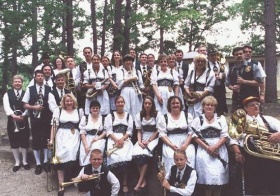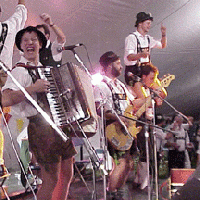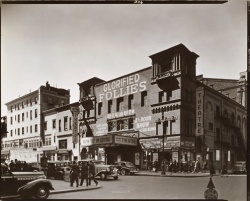From The Peopling of New York City
Contents |
Overview
The German immigrants had many forms of entertainment, but most notably was the role music and theater. Music and theater has served to connect the old country to the new world, and to unite members of the different groups within the German immigrants that came from diverse regions of German-speaking lands.
Music
One of the most resonant and lasting aspects of German culture in America has been its music. From choral societies to brass bands to symphony orchestras, music has been a fundamental part of the German immigrant’s life. Today, a German- American celebration without music is a rarity. Usually, advertisements for gatherings involving traditional German food, drink, and dancing, highlight the band as the main attraction. Music is still in the spotlight at gatherings of German Americans. Musicians of German descent are highly applauded for playing music by German composers in concert halls. Critic, John Sullivan Dwight, applauded the performance of the Germania Musical Society who was touring the United States in an 1852 edition of his Journal of Music. He wrote, “The growing taste for pure instrumental music, at so many points in our wide country, has been greatly indebted for the last three or four years to the flying visits of this model abridgement of an orchestra. Though hardly twenty-four in number, these young artists have diffused among our people something nearer than we have before had, a true idea of German music, both in its popular and is its classic forms.”
In the 20th century, as Germans disperse throughout the United States, music has been the easiest cultural element to travel with them. “[T]he baroque works of Johann Sebastian Bach; the giant of choral and sacred music; the classicism of Wolfgang Amadeus Mozart and Joseph Haydn; and the great German Romantic tradition of Ludwig von Beethoven, Franz Schubert, Robert Schumann, Johannes Brahms, and Richard Wagner” were known to most German immigrants. Thousands of German Americans could play, sing, or listen to these works, at home or in local halls and clubs. Others wrote or adapted folk songs, marches, and church music. German Americans dominated orchestral music in the 19th century, so much so that in 1890, 89 out of 94 performers in the New York Philharmonic were German-born.
Unfortunately, symphonies and operas are no longer considered a popular form of entertainment. Germans are still represented on the concert stages, but the style of music has shifted vastly to popular or electronic music as preferred by Americans. The Liederkranz Society of New York City, founded in 1847, sings the works of German and non-German composers, in both German and English. Just like how the German language has given way to English, German music has yielded to typically American tunes. However, the music presented today still conveys a sense of German traditions. [1]
Theater
Ethnic theater was a primary means for the expression of ethnicity and for displaying and showing aspects of the Old World experience that was worthy of tribute and remembrance. The Germans were the first immigrants to introduce theater and they brought with them the “best-developed theater tradition among the European immigrants.” The Germans brought their taste for German drama with them, and between the second half of the 18th century and the first half of the 19th century, a large amount of German drama was produced. German-language theaters were quickly established to provide the German-speaking population with their beloved drama.
By 1845 the original “Stadttheater”, municipal theater, was offering semi-professional German-language repertory theater in New York. Ten years later the “Neue Stadttheater”, new municipal theater, had established itself as a much improved professional company. The start of the Irving Place Theater in 1892 brought along outstanding performances including German favorites as well as Shakespeare and the French classics in translation. As one contemporary observer said, the Irving Place Theater offered drama “on a higher plane than…in any other theatre in this city…”
The German-American theater has come to represent a major social and cultural dimension of German-American ethnicity. Throughout the 1890s the Germans held claim to three operating playhouses, the Germania, the Thalia, and the Irving Place, and could have held claim to creating a German-American theatrical tradition. [2]
- Return to Entertainment
- Return to Germans


